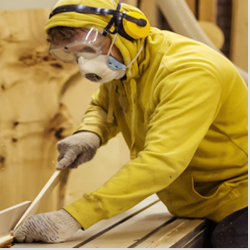Protective respiratory equipment is a central element of proper PPE and is essential in a wide range of work environments. It serves to protect the respiratory system of employees working in environments with high level of dust, oil-based mists, and other airborne particles that could cause internal harm.
Primarily, it’s there to keep particles from entering the lungs where it could build up and do serious damage, but it’s also useful for keeping airways, nostrils, and mouths clear. This can make working in environments with poor air quality much more comfortable.
There is a wide range of different types of respiratory equipment, all best suited to different workplaces or tasks. They include full face masks, helmets, filters and accessories to ensure all levels of respiratory protection are available and protection from airborne particles is provided.
- - Half masks and full face masks – Half masks and full face masks provide an exceptionally reliable level of protection with full face masks providing eye protection in addition to respiratory protection.
- - Respiratory Helmets – Respiratory helmets and hoods offer the greatest level of protection, with a full respiration system built into a protective piece of headwear.
- - Respiratory filters – With respiratory filters from leading brands such as 3M, Scott, Moldex and Elipse, you can replace the filters in your respirators when they become less effective to ensure a high level of dust/oil protection is upheld.
Respiratory protection laws and regulations
The laws surrounding the use of RPE state that a full risk assessment should be carried out prior to equipment being specified and that companies with fewer than five employees are not legally required to record their risk assessment. The law states that RPE should be used when:
- - An inhalation exposure risk remains after other reasonable controls have been put in place
- - When putting in place other control measures
- - For emergency work or temporary failure of controls where other measures are unsuitable
- - When there is infrequent short-term exposure and other measures may be impractical
In addition, all RPE must be looked after properly and stored when not in use in order to maintain working order and product longevity.
European standards and regulations for respiratory protective equipment
There are several standard regulations that cover RPE in Europe, outlining all requirements to abide by the law and minimise risk in the workplace. They are:
- - Personal Protective Equipment Regulations (2002)
- - Personal Protective Equipment at Work Regulations (1992)
- - EN149:1991 - Filtering face piece
- - EN149:2001 - Filtering face piece
- - EN405 - Maintenance free half masks
- - EN136 - Full face mask
- - EN137 - Filtering face piece
- - EN140 - Half mask
- - EN141 - Gas and vapour filters
- - EN143 - Particulate filters
- - EN146 - Filtering face piece
- - EN149 - Filtering face piece for particulates
- - EN149 - Gas and combined filters
- - EN12941 - Power hoods and helmets
- - EN12942 - Powered full face masks
How to choose the correct RPE?
The three key considerations to take into account when specifying any RPE are the wearer, the task in hand and the environment in which the equipment will be used. In addition, there are specific considerations to bear in mind with regards to what is required to protect the worker. These include:
- - The type of hazardous substance being dealt with, and the amount of it which is in the air
- - The nature of the work being carried out
- - The form of the hazardous substance being encountered, e.g. gas, vapour, particle
- - Any specific worker requirements that may be necessary, such as a need to wear spectacles
Once the COSHH (Control of Substances Hazardous to Health) risk assessment has been carried out in order to identify the hazardous substances, the next two key areas to consider are the products used that are classed as hazardous substances and the work activities that may generate harmful substances, such as cutting or heating materials. When deciding on the protection factor required, it is vital to ensure that the RPE selected can adequately protect the worker from the hazardous substance in the air around them, and this decision will be based upon the amount of substance that is present in the immediate atmosphere. If you know what type of respiration equipment you need for your employees, browse our full range of
respiratory protective equipment and order today. Don’t hesitate to contact us if you have any other questions.





Leave a comment